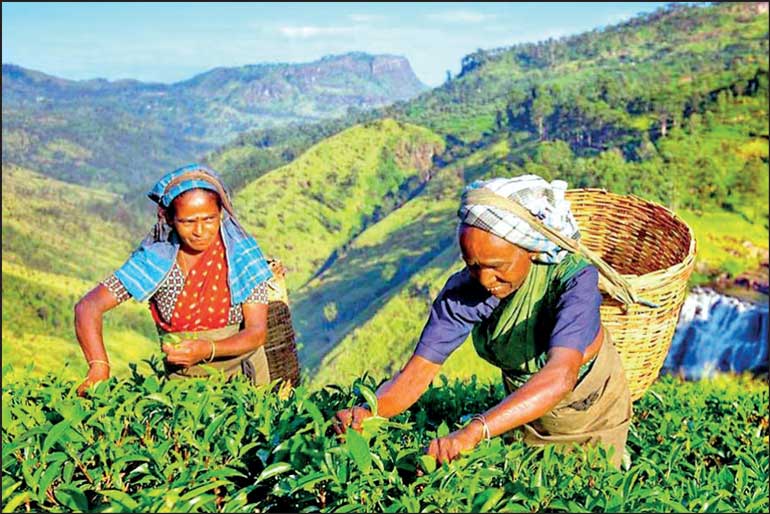Tuesday Dec 16, 2025
Tuesday Dec 16, 2025
Tuesday, 9 July 2024 00:00 - - {{hitsCtrl.values.hits}}

Ceylon Tea – let us regain position of best in the world
 “Ceylon Tea will soon vanish: Yogarajan” – This alarming headline ref Daily Mirror page 12 of Wednesday 26 June 2024 naturally caught my eye being a veteran of more than half a century associated with the myriad wonderful, albeit challenging aspects of tea growing and processing.
“Ceylon Tea will soon vanish: Yogarajan” – This alarming headline ref Daily Mirror page 12 of Wednesday 26 June 2024 naturally caught my eye being a veteran of more than half a century associated with the myriad wonderful, albeit challenging aspects of tea growing and processing.
I would begin this piece by partly agreeing with R. Yogarajan. However, all is not lost for Sri Lanka’s tea sector. I shall submit in point-form at the conclusion of this paper the ‘Absolute need for a long term master plan’ for SL’s tea growing and processing in essence plus other areas such as forestry, renewable energy, training and retention of human capital and more.
There is an absolute need for a common inclusive master plan for the plantation industry in the interests of all stakeholders including Government of Sri Lanka. All stakeholders must work in unison; value chain enhancement is key. There should be priority focus encompassing all 360 Degree elements and the entire plantation industry needs a 5 to 10 year rolling plan along with planning and financing of required investments from both local and foreign sources.
Present scenario
Current production model for tea [and rubber] is unsustainable in long-term
High COPs/Low YPH/volatile market prices make it an almost hopeless situation! We need dynamic vision and boldly state: ‘All is not lost’!
53% of the tea in bearing is still ‘old seedling’ while only 47% is high yielding VP cultivars
As much as 31% of VP tea in RPCs over 30 year old vide TRI sources
Most RPCs have admitted that they do not have funds to re-plant tea
Alarmingly dying/dead bushes are not replaced by most RPCs
Accepted norm/practice of re-planting 03% to 05% revenue extent annually not being adhered to; or even if done, results poor, not impacting positively
Rising production costs/lowering of yields amidst poor demand for much of Sri Lankan teas add to an irreversible, impending calamity!
Market risks and uncertainty continue to rise especially in traditional Arabic markets, together with Russia that have lower demand for SL teas
Way forward
External support needed for long-term financing and regulatory changes
SL could take leaf from India’s ‘Special Purpose Tea Fund’
A similar program can be offered in SL for ALL growers
The ‘Export Levy on bulk teas’ [and/or CESS] could be re-channelled towards fund
Out of SL’s 220,000 ha presently in tea, around 5,000 ha should be aimed at for replanting annually under an accelerated program
Re-planting must be undertaken at an accelerated rate, strictly adhering to accepted TRI advice; higher yielding cultivars with proven enhanced quality e.g. TRI 3000, 4000 and 5000; also planned infilling in only A and B category tea fields with minimum 75% stand so that focus will be to restore balance 25% of vacancies after ascertaining cause of casualties; it is essential that close planting of Mana grass be done and lopped @ 45 days and fertilised @ 90 days for a rehabilitation period of 14 months.
SL needs to target a national tea yield of 3,000kg/ha in 5 years
Get back to the insistence of ‘Quality Leaf’ – this is non-negotiable.
Those RPCs already bankrupt need to be converted to smaller ‘clusters’
Smaller clusters of estates mean less over-heads
Regulatory matters
Please consider lease extensions up to 99 years, starting from RPCs who have consistently conformed to proper agricultural practices
Government imposed restrictions on land use by RPCs should be reviewed
Here let me quote relevant extract from an ex CEO of a RPC:
“The government must monitor all aspects of land use. Accordingly the ‘Offer Letter’ for RPCs must be amended to state that Re-Planting Tea is non-negotiable. The accounting method for depreciation should consider the life cycle of the tea bush, not the remaining Lease Period that the RPCs often use as a reason for not replanting. A thorough Audit needs to be conducted on rehabilitation grass clearings since 1992 to determine the actions taken by the RPCs. Some have abandoned such lands or allowed favourites to engage in various activities. Others have repurposed the land for housing without considering the initial investments. Only a few companies acknowledge these losses and accurately reflect them in their Financial Statements, while others artificially inflate their net assets.” [End of Quote]
Although many RPCs went on to establish fuel-wood and forestry, when harvesting time came along the State Regulatory bodies did not permit harvesting; a Plantation Authority to handle such issues?
Commercial forestry
Commercial forestry and using fuel-wood is the way forward with a miniscule cost per kilo of tea as against exorbitant costs when using liquid fuel
The plantation sector needs around 20,000 ha of commercial forestry
A lush tea field with 13,500 bushes to a ha whilst under required stand of High and Low shade along with leguminous cover crops and green manure trees etc. would mimic a forest with all the positives of a ‘rain-forest’
Ideally each plantation must allocate a mandatory 5% of its extent towards growth of ‘natural forest’ in appropriate areas of each estate.
Move away from mono-crops to max land use
As a policy, the entire plantation industry must move away from perennial ‘Mono-Crop’ model to a ‘Maximum Land
Use’ [MLU] model
To elaborate on MLU whilst some plantation units may have tea as its principle crop one needs to identify other high demand crops: forestry, spices, dairy projects, inland fisheries, cut-flowers, etc. and to allocate worker utilisation only for specific crops instead of lumping all to tea for instance!
Establishing high-quality dairy and pasture management, etc., and enhancing the soil nutrient factors on way ‘towards organic’ in a limited manner
A certain percentage of land-use activities need to be certified organic farmlands conforming to global standards and strictly monitored
The industry needs to invest in training and skills development at all levels
Re-establishment of ‘Trainee Planter Colleges’
Lack of a professional Training College for planters and support staff
The training must include both theory and practice of Finance, all facets of HR Capital Development, soil chemistry; innovative agriculture [e.g. Israeli]
We need specialists in different aspects of the values chain and an overall resident General Manager/CEO of each unit of say, 5,000 Ha
Plantation workers/associates
Break down of estate level discipline due to numerous factors in an environment of anarchy, discipline is the first casualty!
Workers should not be perceived with an adversarial angle and as a mere cost; no wonder there has been an outward migration from estates!
Lower the plantation dependency of manual workers by judicious mechanisation and deploying state-of the-art techniques such as multi-purpose drones and Artificial Intelligence [AI] on a need basis.
The Associates must serve in Quality Circles and even participate in certain decision making processes
Worker housing
The matter of worker housing ownership needs to be reviewed avoiding pitfalls as in the past when some ‘sold’ their abodes to ‘outside mudalalies’
However ownership of say 7 perches of land strategically located for at least 2nd generation families of each plantation with a liveable quarters is the way forward and indeed the future with new paradigms being accepted
Ceylon Tea – let us regain position of best in the world!
Failure to protect ‘Ceylon Tea’ as the best-in-the-world
It is literally so when it leaves factories that sustain A-to-Z ‘Quality Standards’ from Field to Factory and beyond.
Branding blends with non-Ceylon tea, as ‘Ceylon Tea’ with Lion emblem has and will tarnish the good and established Brand of Ceylon Tea synonymous with Lion symbol
Lack of vibrant marketing strategies to project 100% ‘Ceylon Teas’ as the cleanest in the world [really!] and best source of antioxidants;
Packing such top quality leaf in pyramid tea bags, nitrogen-packed for factory freshness; let us realise that SL has the BEST Tea – why ignore this reality? Take cue from global soft drink industry re multiple innovations!
We need to harness today’s online multimedia communication and logistical support services; enhance Ceylon Tea with its proven high levels of polyphenols as an immunity boosting health beverage!
Tea Gardens need to create their niche markets globally moving away from dependency on traditional and stifling Colombo Tea Auctions!
Let us THINK out-of-the-box!
Conclusion
Whilst above synopsis with observations on current scenario and way forward is generic by nature one needs to make comprehensive study of specific RPCs, its soils, perennial crops, man-power needs, existing infrastructure; study latest audited accounts and discuss with Board of Directors their expectations and policies that need to be implemented.
Fundamentally the core asset of any plantation company is the LAND – therein lies enormous potential to make the land ‘work for you’.
As a priority one needs to harness state-of-the-art methodologies such as GPS/Drone surveys in ascertaining ones actual extents in hectares/acres and the specific lands that are already cultivated and cultivable extents after excising rock outcrops and worker-gardens etc.
In today’s context potable water, running streams, etc. have tremendous value – e.g. water bottling and hydropower. Exquisite spots and apt locations lend themselves to Eco, Adventure and Agro-Tourism.
With food shortages looming one needs to realise the stark value in agricultural lands for growing of food – vegetables, fruits, greens, etc. with a planned professional outlay as opposed to methods deployed by typical farmers associated with minimum post-harvest technologies, etc.
The coronavirus pandemic has shifted goal posts in corporate entities – one needs to seek business opportunities that are lying latent, to be tapped in a sustainable manner as opposed to exploitive methods so as to conform to enhancing air quality, soil carbon to be elevated and to improve the overall quality of the patch of mother-earth that each RPC has direct leverage towards its optimum green sustenance.
Land, air, soils and water along with its precious fauna and flora with trained human capital – isn’t it then a paradise in waiting for Sri Lanka?
(The writer is Ex-Member World Bank Expert Panel – Plantations Specialist Tea Plantations Management and could be reached via email at [email protected].)